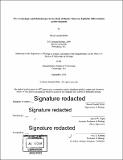New technologies and methodologies for the study of human mammary epithelial differentiation and development
Author(s)
Miller, Daniel Handel
DownloadFull printable version (42.21Mb)
Other Contributors
Massachusetts Institute of Technology. Department of Biology.
Advisor
Piyush B. Gupta.
Terms of use
Metadata
Show full item recordAbstract
The mammary gland is unique among human tissues in that the bulk of its development occurs postnatally, under hormonal control. The gland consists of an epithelium that expands dramatically during puberty and pregnancy, and is the site of breast cancer initiation. Important connections between normal developmental signaling and breast cancer biology are evidenced by the molecular similarities between tumors and normal cell types. Thus, understanding how mammary differentiation is regulated has long been a goal in oncology and developmental biology. Researchers have relied on animal models and in vitro assays to study mammary development for decades. However, differences between the human and murine gland, from the morphology of the epithelium to the composition of the stroma, limit the utility of mouse models. Likewise, in vitro assays subject cells to non-physiological conditions that dramatically affect their behavior. In addition, the majority of experimental approaches used to study the cell states and differentiation regulators have relied on a candidate-based approach. While these studies have explored the roles of signaling pathways such as Wnt, which have known functions in other tissue-specific stem cell states, unbiased strategies to identify cell state regulators have been lacking. For these reasons, I have developed new experimental tools and unbiased strategies to identify genes that regulate mammary development and differentiation. In this thesis, I describe the development of a novel 3D tissue culture system that uses a hydrogel formulated to closely mimic the human stroma. This hydrogel provides a physiological context to study tissue development and processes like ductal initiation and branching morphogenesis, in real time. I also describe two studies that utilized unbiased methods to identify regulators of mammary stem cells and differentiation. The first study identified BCL1 lB as a driver of mammary stem cell self-renewal by inhibiting basal lineage commitment. The second study found that the collagen receptor, DDR1, is required for mammary stem cell differentiation into mature basal cell states, and that this process also drives luminal differentiation through interlineage Notch signaling. These studies provide a new set of tools to better understand human mammary biology, and further our understanding and treatment of breast cancer.
Description
Thesis: Ph. D., Massachusetts Institute of Technology, Department of Biology, 2018. Cataloged from PDF version of thesis. "September, 2018." Includes bibliographical references.
Date issued
2018Department
Massachusetts Institute of Technology. Department of BiologyPublisher
Massachusetts Institute of Technology
Keywords
Biology.